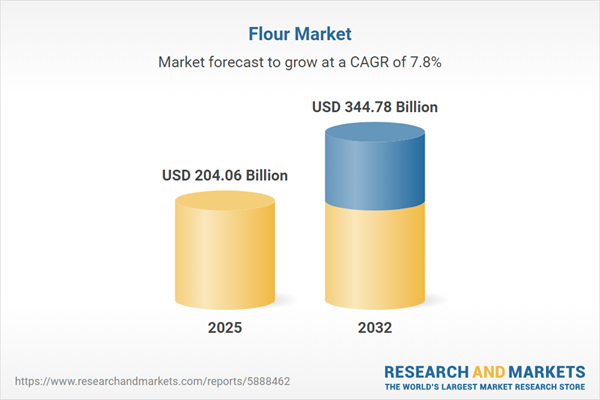Speak directly to the analyst to clarify any post sales queries you may have.
The global flour market is experiencing significant transformation, as new regulations, digital advancements, and evolving procurement trends redefine strategic priorities for senior leaders. Organizations must embrace actionable intelligence to navigate supplier relationships and procurement frameworks effectively.
Market Snapshot: Global Flour Market Size, Growth, and Momentum
Between 2024 and 2032, the global flour market is expected to achieve substantial expansion, underpinned by innovations in manufacturing technologies and diversified product development. Businesses are updating operational models to maintain competitive efficiency. Adjustments in trade practices and the adoption of advanced procurement solutions are altering the global landscape. Adaptable organizations that respond rapidly to shifts in buying patterns are well-positioned to realize measurable gains across dynamic supply chains.
Scope & Segmentation: Comprehensive Flour Market Analysis
- Flour Types: Buyers continue to rely on wheat-based flours such as all-purpose, bread, cake, self-rising, and whole wheat. At the same time, demand is rising for corn, almond, chickpea, and coconut flours, which cater to nutrition-driven and specialty market requirements.
- Applications: The flour sector supplies core ingredients to bakeries, confectionery producers, pasta and noodle manufacturers, as well as suppliers of health-oriented blends. Specialized formulations enable procurement strategies aligned with sector-specific or local market demands.
- Distribution Channels: Businesses are optimizing procurement through supermarkets, hypermarkets, convenience retailers, e-commerce, and dedicated suppliers, responding to the growing need for flexible, omnichannel fulfillment options and overall digital optimization.
- Packaging Formats: Procurement teams require packaging that meets multiple demands, ranging from industrial bulk sacks over 25 kg, to intermediate-sized options up to 5 kg, and smaller retail packs under 1 kg for consumer-targeted sales.
- Grade Options: Both conventional and organic flour grades are available. The importance of nutrition and ESG goals is growing, compelling organizations to choose suppliers that meet robust quality and sustainability standards.
- Regional Dynamics: The flour market’s structure is highly influenced by unique regional approaches in the Americas, Europe, Middle East, Africa, and Asia Pacific. Regulatory landscapes, technological adoption, and compliance priorities vary, as seen in major markets such as the United States, China, India, Japan, Germany, and Australia.
- Industry Leaders: Key players, including Archer Daniels Midland Company, Cargill, Ardent Mills LLC, General Mills, China National Cereals, Oils and Foodstuffs Corporation, Wilmar International, Bunge Limited, Associated British Foods, GrainCorp Limited, and Grupo Minsa, consistently drive sector innovation and shape procurement decisions.
Key Takeaways for Senior Decision-Makers
- Expanding product portfolios with specialty and health-focused flours opens access to emerging buyer segments and extends reach in shifting markets.
- Implementation of advanced milling and packaging solutions strengthens scalability and supports rapid response to evolving customer requirements across multiple distribution networks.
- Maintaining transparent labeling and responsible sourcing within procurement processes sustains regulatory alignment and encourages long-term trust among B2B and downstream buyers.
- Leveraging digital procurement technology heightens transparency and agility, equipping teams to adapt seamlessly to both traditional and innovative distribution channels.
- Fostering close collaboration among compliance, product, and development leads accelerates speed-to-market while helping manage regulatory obligations proactively.
Tariff Impact: Navigating Trade and Policy Shifts
Recent changes in U.S. tariff policy have created additional complexity for organizations sourcing both base and specialty flours. As a result, many are diversifying supplier networks, prioritizing regional partnerships, and enhancing local production capabilities to strengthen supply chain resilience and minimize exposure to policy shifts.
Methodology & Data Sources
The analysis combines direct feedback from leading market participants with verification against the latest regulatory data, reputable industry databases, and trusted publications. Advanced modeling and triangulated analytics are applied to validate all projections and recommendations, ensuring a strong foundation for senior B2B stakeholders.
Why This Report Matters
- Senior teams gain actionable market analysis designed to optimize procurement and enhance overall supply chain strategies within the flour industry.
- Clear insight into regulatory developments and digital transformation supports informed risk management and stronger alignment with industry standards.
- Flexible, region-specific perspectives empower leaders to proactively address compliance and respond to evolving commercial opportunities.
Conclusion
This report delivers targeted, data-driven market insights, enabling industry leaders to make sound strategic choices and build operational resilience in a rapidly evolving global flour marketplace.
Additional Product Information:
- Purchase of this report includes 1 year online access with quarterly updates.
- This report can be updated on request. Please contact our Customer Experience team using the Ask a Question widget on our website.
Table of Contents
3. Executive Summary
4. Market Overview
7. Cumulative Impact of Artificial Intelligence 2025
Companies Mentioned
The companies profiled in this Flour market report include:- Archer Daniels Midland Company
- Cargill, Incorporated
- Ardent Mills LLC
- General Mills, Inc.
- China National Cereals, Oils and Foodstuffs Corporation
- Wilmar International Limited
- Bunge Limited
- Associated British Foods PLC
- GrainCorp Limited
- Grupo Minsa, S.A.B. de C.V.
Table Information
| Report Attribute | Details |
|---|---|
| No. of Pages | 182 |
| Published | November 2025 |
| Forecast Period | 2025 - 2032 |
| Estimated Market Value ( USD | $ 204.06 Billion |
| Forecasted Market Value ( USD | $ 344.78 Billion |
| Compound Annual Growth Rate | 7.7% |
| Regions Covered | Global |
| No. of Companies Mentioned | 11 |









